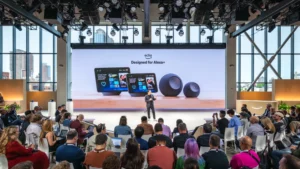Amazon is architecting and building home-based hardware that listens, understands, and proactively responds to its users, with the latest introduction of a new generation of smart home devices that are powered by cutting-edge artificial intelligence (AI).
These latest suites of devices are built around Amazon’s enhanced Alexa+ AI assistant, combining advancements in custom AI chips, sensor fusion, and smart integration to create an ambient experience that feels intuitive, personalized, and all-round connected.
What’s New On The Smart Home Front?
Amazon launched four distinct Echo devices designed for seamless Alexa+ interaction, each equipped with custom-designed silicon chips AZ3 and AZ3 Pro, as well as a new AI accelerator. These Echo devices include Echo Dot Max, Echo Studio, Echo Show 8, and Echo Show 11.
The top-tier Echo Studio model comes with AZ3 Pro and offers spatial audio with Dolby Atmos support, providing a rich auditory experience that comes in a 40% smaller frame and design than before.
The Echo Dot Max was built to enhance voice recognition speed and bass, which makes it the most responsive and muscular Dot to date. Then, there are the Echo Show 8 and Echo Show 11, both featuring edge-to-edge displays with improved audio and video capabilities to deliver personalized visual notifications and smart home control.
Additionally, Amazon’s adoption of its OmniSense sensor-fusion platform represents a leap forward in its ambient intelligence. It cleverly synthesizes data from visual, audio, and radar sensors to recognize who is in the room, while automatically deploying custom routines or sending alerts based on user presence.
For example, these line of home devices powered by Alexa+ can detect specific individuals and send notifications or home security alerts accordingly. This means Amazon’s smart home devices aren’t just built to be reactive as they can also anticipate and tailor interaction to the people in their vicinity.
Equally notable in this launch is Amazon’s expansion of AI capabilities in the smart home camera and security lineup. Both Ring and Blink cameras have been enhanced to 4K with AI-powered driven image tuning, advanced detection technologies.
The Ring Wired Doorbell Pro, for instance, boasts “Retinal Vision,” an AI feature that sharpens image clarity across different lighting conditions. Blink’s new Mini Outdoor 2K+ and Arc cameras, through their dual-camera design, are also AI-powered, enabling and helping users better distinguish details in images more accurately.
These enhancements also come paired with privacy-centric AI controls, “delivering superior image quality in a compact, affordable design” and “featuring 2K resolution and smart features, making advanced security accessible to more consumers,” Amazon said in a press release.
Streaming and entertainment also benefit from these AI upgrades and integration in Amazon’s Fire TV line. The new Fire TV Stick 4k Select includes a revamped operating system promising faster performance and smart content discovery driven and powered by AI insights.
This, and other Fire TV models, feature Ambient Experience that can power the TV on when someone enters the room, which makes the entire viewing experience more “responsive and efficient.”
Amazon also spotlighted its Fire TV Omni QLED series, newly equipped with AI-powered brightness and sound adjustment technologies.
And the Kindle lineup was refreshed with AI-infused features. The Kindle Scribe Colorsoft debuts as the first e-reader with a color e-ink display, enhanced by AI functions for smarter note-taking and content search.
This ultimately blends the traditional Kindle reading experience with modern productivity enhancements, as the combination of AI and e-ink technology pushes the boundaries of what digital reading devices can do.
Why Does This Upgrade From Amazon Matter?
Amazon’s commitment to building smart types of hardware that are infused with advanced AI and sensor fusion, especially when it is purpose-built for homes, continues to make a paradigm shift in the industry of purpose-built tech and sends a message to its competitors – Apple, Google, etc.
The tech company continues to move beyond building voice command responsiveness for its popular AI voice assistant Alexa, moving into the realm of ambient, context-aware intelligence that adapts continuously to users’ lives.
For industry competitors and developers, Amazon is setting a benchmark for how AI hardware can augment everyday living with seamless integration and meaningful intelligence. As such, they must now match or exceed the level of ambient intelligence and AI-powered personalization that Amazon is building.
For consumers, this means smarter homes that don’t just react but anticipate and personalize in a smarter way.
As AI-powered consumer tech evolves at a rapid pace, Amazon’s launch of an AI-powered and purpose-built hardware line emphasizes that smart home innovation is just getting started. The boundaries between devices, users, and their environments are blurring, which also ushers in a new future where these devices feel more like attentive companions than static appliances.
The challenge ahead will be balancing this intelligence with ethical privacy and security as Amazon continues to tread the path of building advanced AI-powered hardware.

